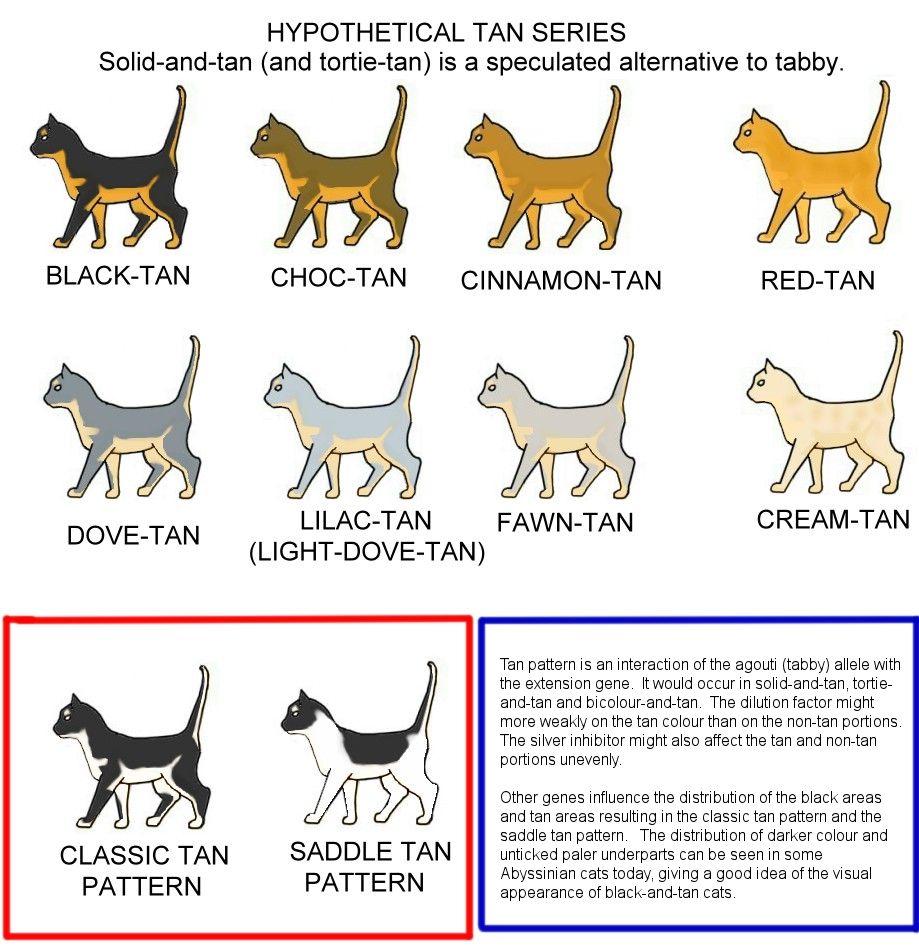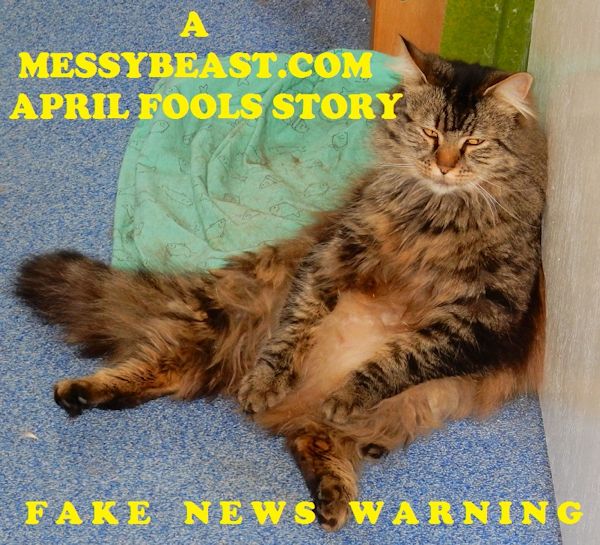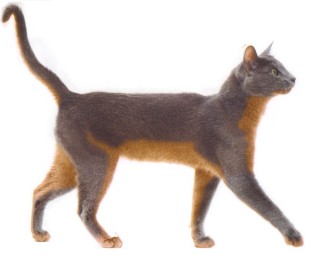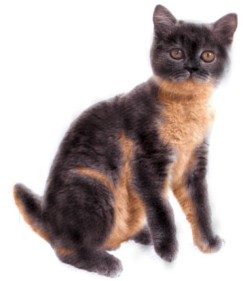
TAN SERIES CATS

Black Tan, Dove (Blue) Tan, Chocolate Tan and Lilac Tan
Having become extinct in England prior to the 1940s, the Black Tan re-emerged in Europe in a family of non-pedigree shorthair cats. As the name implies, the original colour of the variety was glossy black with rich red-tan underparts. Cats of this type had been exhibited as the "Black-and-Tan" in the 1880s in England, but the emphasis on other colours and on Persian longhair cats resulted in its loss early in the history of the cat fancy. Perhaps it might have survived had there existed Black Tan Longhairs, but it was not desirable to cross longhairs to shorthairs in those historical days.

After the Black Tan, the Dove (Blue) Tan was developed at the turn of the 20th century, most likely as a result of crossing a Black Tan to a Russian Blue or Maltese (Blue shorthair cat) and introducing the dilution factor. The first Chocolate Tans appeared in the 1920s as a result of crossing the Black Tan and the "brown Siamese" (a self brown cat of Siamese type). The Lilac Tan is the dilute of Chocolate Tan and comes from breeding Chocolate Tans with Blue Tans or Maltese cats. These crossings with Russian Blue cats and Siamese/Burmese resulted in a moderately foreign body type compared to the stocky British shorthair; it also gave the coat a distinctive sheen called "polish" by those early breeders.
In breeding Tan series cats, black were bred either to black or to blue to give blacks and blues without too much washing out of the tan colour. Breeding Blue Tans together had a tendency to dilute the desired rich tan colour of the underparts and risked a cat that looked more like a blue-cream. Likewise, chocolate was bred to chocolate or to lilac to get both chocolates and lilacs; breeding lilac to lilac risked diluting the tan colour. Although black to chocolate or black to lilac crosses were known to produce very high quality Black Tans, there was the accompanying danger of losing the rich tan colour in subsequent generations. With this risk in mind, such breedings were sometimes required to prevent weakening of the conformation.
Interestingly, the dense black colour of the upper parts of the Black Tan was found to not fade to rusty brown or coffee brown in sunlight or after taxidermy. Several early fanciers preserved their best specimens in this way and commented on the fade-resistance, but unfortunately these specimens have not survived to the present day. After the Second World War, neither preserved specimens nor living cats in the Tan series were known to exist. The modern cats of this type are believed to be unrelated to early Tan cats, being due to mutation in a family of farm cats. These too might have been unnoticed but for the sharp eyes of a German student engaged in volunteer work in Albania.
The Genetics
Colour-and-tan appears to be an allele of tabby, but the variety is too recently re-emerged for the exact relationship to tabby and to agouti to be clear. The inheritance of black, blue, chocolate and lilac are in accordance with known principles. The dilution gene works on both component colours, but less so on the tan of the underpart than on the colour of the upper part of the cat.
Test matings with agouti (ticked) cats have resulted in first generation offspring being agouti. Breeding the offspring together results in a mix of agouti and colour-and-tan. It is therefore not possible to breed Ticked tan individuals.
A cross between a brown (black) tabby and a Black Tan unexpectedly resulted in all solid black offspring. Breeding the offspring together resulted in both tabby and black-and-tan. This was contrary to expectations since black is recessive to the tabby pattern. The appearance of "dominant black" in the offspring may explain why the black colour is "fade-resistant". A previous report of presumed "dominant black" is known from Robinson's "Genetics for Cat Breeders". In order to keep presumed dominant black and usual recessive black separate, breeding tabby to colour-and-tan should be avoided. It is therefore not possible to breed Tabby Tan or Spotted Tan individuals.
Because red (orange) pigment is an alternative to black pigment and always displays phantom tabby markings, it is possible to breed red/red tabby tans and cream/cream tabby tans. However there has been found poor contrast between the red/red tabby and tan colours. Because the dilution affects both the tan region and the red/red tabby region differently, cream tans display darker underparts in comparison to cream upper parts; this is a reverse of the normal pattern of contrast. Tortoiseshell Tans, being also caused by the red gene, are likewise possible.
Tan also combines with the white spotting factor, but the cats will tend to appear calico depending on the placing and degree of white. The interaction with the colour inhibitor (silver) gene has not been investigated. Black tan smoke is to be expected, however chinchilla tan and shaded silver tan will be absent because tan appears to dominate over tabby, the latter being a necessary component for silvers. These are investigations for the consideration of future breeders.
Standard

There is currently no formal standard for a Tan breed, nor are there plans to introduce the colour into existing breeds. It currently exists as a curiosity in the hands of a very few breeders. The few existing cats are moderately foreign in type, not as extreme as the Siamese/Oriental, but not cobby like the British or Exotic Shorthair. The Tan pattern might also be shown to good effect on traditional conformation Persian Longhairs and Chinchilla Persians.
From a historical view, colours are Black, Dove (Blue), Chocolate and Lilac. These are the colours of the back, head, top of the tail and outsides of the legs. The belly, chest, throat, chin, underside of the tail and insides of the legs are tan. This should be a rich, red tan in combination with black or chocolate; or fawn to pale tan when in combination with the dilute colours of dove and lilac. There may be tan markings above the eyes, at the base of the ears and on the whisker pads.
Interested? Sorry, but right now the Tan series in cats is the Messybeast April Fool's joke 2005.
